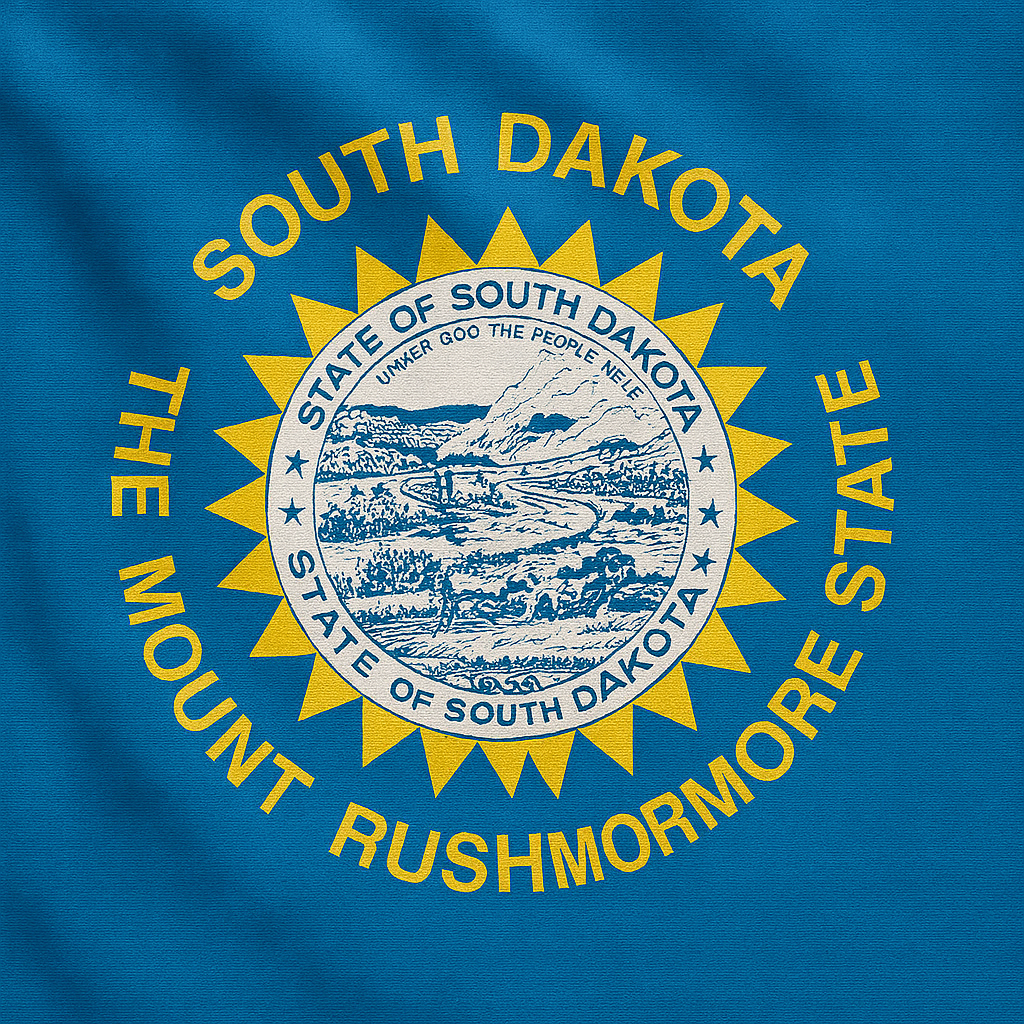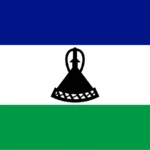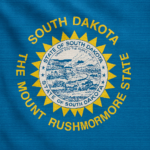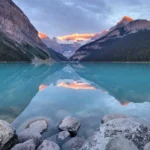
South Dakota flag
South Dakota may be best known for the towering faces of Mount Rushmore, but this Midwestern gem holds far more than meets the eye. From record-breaking geological formations and ancient fossil beds to massive sculptures and legendary Wild West towns, South Dakota is a state rich in history, science, and cultural heritage. In this post, we’ll explore 25 fascinating and numerically detailed facts that showcase the state’s unique character—from the largest mountain carving in the world to the third-longest cave system on Earth. Whether you’re a trivia enthusiast, a history buff, or simply curious about the wonders tucked away in the Great Plains, these facts will give you a deeper appreciation for the Mount Rushmore State.
1. Statehood Date
South Dakota officially became the 40th state of the United States on November 2, 1889, the same day as North Dakota. President Benjamin Harrison deliberately shuffled the order of signing to avoid favoritism, so the exact sequence remains unknown. This moment marked the formal division of the Dakota Territory, which had been established in 1861 and later split into two states due to political and population differences.
2. Mount Rushmore Dimensions
Mount Rushmore is one of the most iconic monuments in the United States, featuring 60-foot-tall granite faces of Presidents George Washington, Thomas Jefferson, Theodore Roosevelt, and Abraham Lincoln. The sculpture is carved into a 6,200-foot mountain in the Black Hills and took 14 years to complete, from 1927 to 1941, under the direction of sculptor Gutzon Borglum. Despite its monumental scale, the project cost only $1 million, a modest sum considering its enduring cultural and historical significance.
3. Crazy Horse Memorial
The Crazy Horse Memorial, still under construction, is set to become the largest mountain carving in the world, measuring 563 feet high and 641 feet long. Located near Mount Rushmore, it honors the Lakota warrior Crazy Horse and was initiated in 1948 by sculptor Korczak Ziolkowski. When completed, it will dwarf Mount Rushmore and serve as a powerful tribute to Native American heritage and resistance.
4. Jewel Cave
Jewel Cave, located in the Black Hills of South Dakota, is the third-longest cave in the world, with over 120 miles of mapped passages. Discovered in 1900, it was named for its sparkling calcite crystals that resemble jewels. The cave system features rare formations such as flowstone, frostwork, and hydromagnesite balloons, making it a geological treasure and a popular destination for spelunkers and scientists alike.
5. Wind Cave
Wind Cave National Park is home to one of the most complex cave systems in the world, with over 82 miles of mapped passages. It is renowned for its boxwork formations, which are made of thin calcite fins and are found nowhere else in such abundance. Established in 1903, it was the first cave to be designated a national park in the world, highlighting its unique geological and ecological importance.
6. Badlands National Park
Badlands National Park spans 244,000 acres and contains some of the richest fossil beds from the Oligocene epoch, dating back 23 to 35 million years. The park’s sharply eroded buttes and pinnacles are composed of sedimentary rock layers that preserve ancient mammals like saber-toothed cats, rhinoceroses, and three-toed horses. Its dramatic landscape and paleontological significance make it a key site for both tourism and scientific research.
7. Harney Peak (Black Elk Peak)
Black Elk Peak, formerly known as Harney Peak, rises to 7,242 feet above sea level, making it the highest point in the United States east of the Rocky Mountains. Located in the Black Hills, it offers panoramic views and is a sacred site for the Lakota Sioux. The peak was renamed in 2016 to honor Black Elk, a revered Lakota medicine man and spiritual leader.
8. Homestake Mine
The Homestake Mine in Lead, South Dakota, was the largest and deepest gold mine in North America, operating for 125 years until its closure in 2002. It reached depths of over 8,000 feet and produced more than 40 million ounces of gold during its lifetime. Today, the site hosts the Sanford Underground Research Facility, where scientists study neutrinos and dark matter in a uniquely shielded environment.
9. USS South Dakota
The USS South Dakota (BB-57) was a battleship that served with distinction during World War II, earning 13 battle stars and Navy Unit Commendations. It participated in major Pacific battles including Guadalcanal, the Philippine Sea, and Okinawa. Its impressive combat record makes it the most decorated U.S. battleship of the war, and a memorial in Sioux Falls honors its legacy.
10. Custer State Park Bison Herd
Custer State Park is home to one of the largest publicly owned bison herds in the world, with approximately 1,500 free-roaming bison. Each adult bison can weigh up to 2,000 pounds, and the park hosts an annual Buffalo Roundup that draws thousands of spectators. The event helps manage the herd and preserves the ecological balance of the park’s 71,000 acres.
11. Black Hills National Cemetery
Known as the “Arlington of the West,” the Black Hills National Cemetery near Sturgis serves as a solemn resting place for thousands of U.S. veterans. Established in 1948, it spans 105 acres and includes graves from every major American conflict since World War I. Its serene setting and military honors make it a place of deep national reverence.
12. Mammoth Site of Hot Springs
The Mammoth Site in Hot Springs contains the largest concentration of Columbian and woolly mammoth bones in their primary context in the world. Discovered in 1974, the site has yielded remains of over 60 mammoths, along with other Ice Age animals. It is an active paleontological dig and educational center, attracting researchers and visitors from around the globe.
13. Belle Fourche
Belle Fourche was designated in 1959 as the geographical center of the United States after the addition of Alaska and Hawaii. A monument called a “Stone Johnnie” marks the spot, located just outside the town. This central location has made Belle Fourche a symbolic crossroads of the nation and a point of pride for South Dakotans.
14. South Dakota State University
South Dakota State University (SDSU), located in Brookings, is the largest university in the state, with an enrollment of over 8,100 students and nearly 2,000 staff. Founded in 1881, it is a land-grant institution known for its research in agriculture, engineering, and nursing. SDSU plays a vital role in the state’s educational and economic development.
15. Sturgis Motorcycle Rally
The Sturgis Motorcycle Rally, held annually in the town of Sturgis, is one of the largest motorcycle rallies in the world, attracting hundreds of thousands of bikers. Founded in 1938, the event spans over a week and includes concerts, races, and scenic rides through the Black Hills. It generates millions in revenue and transforms the small town into a global hub for motorcycle enthusiasts.
16. Flaming Fountain
The Flaming Fountain in Pierre is a unique veterans’ memorial fed by an artesian well that emits natural gas. The gas is so rich it can be lit perpetually, creating a continuous flame over the water. This rare geological phenomenon serves as a poignant tribute to South Dakota’s fallen soldiers and is located near the State Capitol Lake.
17. Meridian Bridge
Built in 1924, the Meridian Bridge was the first structure to span the Missouri River in South Dakota, connecting Yankton to Nebraska. Originally a double-deck vertical lift bridge, it allowed both rail and automobile traffic. Today, it serves as a pedestrian and bike path, preserving its historical significance while adapting to modern use.
18. Prairie Rattlesnake
The Prairie Rattlesnake is the only venomous snake native to South Dakota and can grow up to 5 feet long. It is typically found in the western part of the state and has a distinctive greenish-brown color with oval blotches. Though venomous, it plays an important role in the ecosystem by controlling rodent populations.
19. Palisades State Park
Palisades State Park features dramatic Sioux quartzite formations estimated to be 1.2 billion years old, making them among the oldest exposed rocks in North America. The park’s spires and cliffs rise sharply from Split Rock Creek, creating a stunning geological landscape. It is a popular destination for rock climbing, hiking, and photography.
20. Potato Wrestling Capital
Clark, South Dakota, is known as the Potato Capital and hosts the world-famous Mashed Potato Wrestling contest during its annual Potato Day celebration. Participants wrestle in vats filled with mashed potatoes, drawing crowds and media attention. The event highlights the town’s agricultural heritage and adds a quirky charm to its identity.
21. Deadwood Gold Strike
In 1875, the discovery of gold in Deadwood Gulch sparked a rush that transformed the area into a legendary Wild West town. The strike led to rapid population growth and lawlessness, attracting figures like Wild Bill Hickok and Calamity Jane. Deadwood’s gold boom played a pivotal role in South Dakota’s early development and remains a major tourist attraction.
22. Woonsocket’s Lake Prior
Lake Prior sits in the middle of Woonsocket, giving the town its nickname: “The Town with the Beautiful Lake.” The lake is a central feature of community life, hosting events, fishing, and recreation. Its unique location makes Woonsocket one of the few towns in the U.S. with a natural lake at its heart.
23. Anne Hathaway Cottage
Wessington Springs is home to the only structure in the Midwest with a thatched roof, modeled after Anne Hathaway’s Cottage in Stratford-upon-Avon, England. Built in 1938, the replica honors Shakespeare’s wife and serves as a cultural landmark. It reflects the town’s appreciation for literature and architectural uniqueness.
24. George S. Mickelson Trail
The George S. Mickelson Trail stretches 114 miles from Deadwood to Edgemont and is South Dakota’s premier rails-to-trails project. Named after the late governor who championed its creation, the trail traverses scenic landscapes including forests, tunnels, and bridges. It is a favorite among hikers, bikers, and horseback riders seeking a peaceful journey through the Black Hills.
25. State Area
South Dakota covers 77,121 square miles, making it the 17th largest U.S. state by area. It is divided into two distinct regions: East River and West River, separated by the Missouri River. This vast expanse includes prairies, mountains, lakes, and national parks, offering a diverse and rich natural environment.
FAQs about South Dakota:
1. When did South Dakota become a state?
South Dakota was admitted to the Union on November 2, 1889, alongside North Dakota. President Benjamin Harrison signed both statehood proclamations on the same day but shuffled the documents to obscure which was signed first. South Dakota became the 40th state of the United States.
2. What is the capital of South Dakota?
The capital of South Dakota is Pierre, pronounced “peer.” It is one of the smallest state capitals by population, with around 14,000 residents, and is uniquely notable for being the only U.S. capital city that does not share a single letter with its state’s name.
3. What is the largest city in South Dakota?
Sioux Falls is the largest city in South Dakota, with a population exceeding 200,000. It serves as a major economic and cultural hub for the region and is known for its healthcare, finance, and manufacturing industries.
4. What is South Dakota’s nickname?
South Dakota is officially nicknamed “The Mount Rushmore State” in honor of the famous presidential monument carved into the Black Hills. The nickname reflects the state’s strong association with American history and tourism.
5. What states border South Dakota?
South Dakota shares borders with six states:
- North Dakota to the north
- Minnesota and Iowa to the east
- Nebraska to the south
- Wyoming and Montana to the west
6. What is the highest point in South Dakota?
The highest point is Black Elk Peak (formerly Harney Peak), which rises to 7,242 feet above sea level. Located in the Black Hills, it is the tallest summit east of the Rocky Mountains in the United States.
7. What is the lowest elevation point in South Dakota?
The lowest point is the shoreline of Big Stone Lake, located in the northeastern part of the state, with an elevation of 966 feet above sea level.
8. What is the state motto of South Dakota?
South Dakota’s official motto is “Under God the People Rule.” This phrase reflects the state’s values of democracy, faith, and civic responsibility.
9. What is the state bird of South Dakota?
The Ring-necked Pheasant is South Dakota’s state bird. Introduced in the early 1900s, it has become a symbol of the state’s rich hunting culture and rural heritage.
10. What is the state animal of South Dakota?
The Coyote is the official state animal. It represents adaptability and resilience, traits valued in South Dakota’s rugged landscape.
11. What is the state fish of South Dakota?
The Walleye is South Dakota’s state fish. It is a popular catch in the state’s lakes and rivers, especially in the Missouri River system.
12. What is the state flower of South Dakota?
The American Pasque Flower is the state flower. It blooms early in spring and is known for its lavender petals and hardiness in cold climates.
13. What is the state mineral of South Dakota?
Rose Quartz is the official state mineral. It is found in the Black Hills and is prized for its pink hue and ornamental use.
14. What is the state insect of South Dakota?
The Honey Bee is South Dakota’s state insect. It plays a vital role in agriculture and pollination across the state’s vast farmland.
15. What is the state gemstone of South Dakota?
The Fairburn Agate is the state gemstone. It is a rare and colorful agate found primarily in the Fairburn area and is highly valued by collectors.









